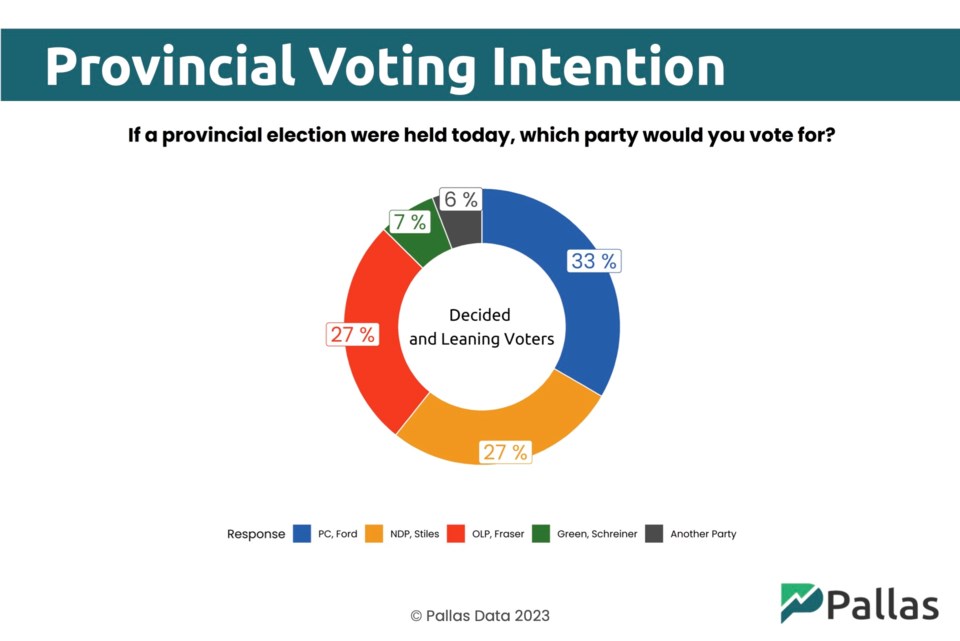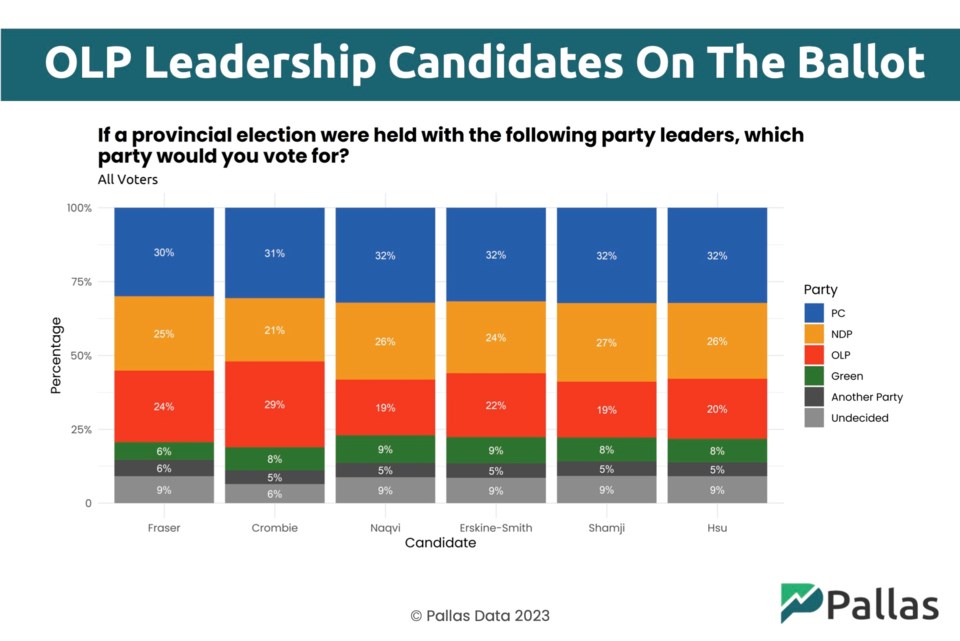Editor's note: Trillium Insiders got early access to this poll on Friday in a story on its findings on the Liberal leadership race. Insiders can still read that story here, or continue reading for our reporting on those findings below. This article originally appeared on The Trillium, a new Village Media website devoted exclusively to covering provincial politics at Queen’s Park.
Doug Ford's Progressive Conservative party has an uncomfortable lead in the polls.
A new Pallas Data poll conducted for The Trillium last week found support for the PCs has hit its lowest point since the 2022 election at 33 per cent, with the NDP and the Ontario Liberal Party close behind, neck-and-neck at 27 per cent each.

According to Pallas Data CEO Joseph Angolano, if there was an election with these results it would likely have resulted in a slim majority government for the Ontario PCs, given the split between the NDP and Liberal parties.
However, in the past when the PCs have earned only a third of the votes in a general election, they have not formed government.
"When an election is called, that hypothetical becomes reality," said Angolano. "And then people think about it a little bit more, they start talking about it with their friends or family and start paying a little more attention to the news and social media."
When only one in three voters support the PCs, the party has neared its modern electoral floor, he added.
In both the 2018 and 2022 elections, the party earned over 40 per cent support, making Ford premier.
In the four elections before that, the PCs won 31 to 35 per cent support, making them the Official Opposition to the Liberals.
When Mike Harris won electoral victories his party's support was in the mid-'40s.
The low-water mark for the party was more than three decades ago: in 1987 and 1990, when it earned 25 and 24 per cent, respectively, giving it third-party status in the legislature.
But in between Ford's two victories, the PCs polling numbers dipped down to the low-30s, before they recovered in the lead-up to the 2022 election, notably in Ford's first year in office and at times during the COVID-19 pandemic, including in 2021 after the unpopular decisions to close playgrounds and beef up police powers, which were swiftly reversed.
Ford has again reversed course on an unpopular decision: opening up parts of the Greenbelt to development.
In late September, the premier apologized for the "terrible" process his government used to select lands from the Greenbelt to be opened for development, and pledged to re-protect those lands and never touch the Greenbelt again.
His party's numbers are down from a month ago, compared to a poll taken before his promise to re-protect the Greenbelt.
That poll, conducted Aug. 28-29, also had the PCs in the lead: 37 per cent of decided and leaning voters would choose Ford's PCs in an election, compared to 27 per cent for the Liberals, 26 per cent for the NDP and 5 per cent for the Greens. It was taken after the province's former auditor general released her damning report on the Greenbelt process but before the province's integrity commissioner's report. It was also before the resignation of two cabinet ministers over the scandal.
Liberal leadership numbers
The Pallas Data poll also tested the impact of the Ontario Liberal Party leadership race on the parties' standings.
It found Mississauga Mayor Bonnie Crombie is the only Liberal leadership candidate who'd give the party a boost. In fact, if there was an election held when the poll was conducted last week, a Crombie Liberal party could have reduced the Progressive Conservative government to a minority, Angolano said.
Pallas asked respondents how they'd vote in an election held that day if each of the leadership candidates were the leader of the Liberal party, and compared that to the results they'd given with interim leader John Fraser at the helm.

Overall, 29 per cent of respondents said they'd vote for Crombie's Liberals, a five-point bump over the party's standing with the interim leader. She'd be just two points shy of Ford's PCs at 31 per cent, with 21 per cent for Marit Stiles' NDP and 8 per cent for Mike Schreiner's Greens. Substituting any of the other leadership candidates for the interim leader lowered the Liberal vote in the test.
"She's the only one adding any sort of value to the OLP vote," said Angolano. "If she were leader with these numbers today, it would make it very close — it would probably be a PC minority, looking at the regional breakdowns."
A Crombie-led Liberal party would be dominant in Toronto and statistically tied in the Greater Toronto Area, he said.
Crombie would pull significant support from the NDP, Angolano said. Of the respondents who initially said they'd vote NDP, nearly one in five said they'd vote Liberal if Crombie was the leader.
That was especially interesting considering Crombie's comments at the outset of the campaign about the Liberal party having moved "much too far to the left," Angolano said, adding that whoever wins the Liberal leadership would likely need to pull votes from the NDP to win a majority government.
Name recognition is likely a factor, he said.
"She is certainly the best-known of the candidates. That said, we do have a former minister here with Yasir Naqvi and he's not pulling anything near what Bonnie Crombie is," said Angolano.
"This could, of course, all change. What if she does win the leadership? There's going to be a new focus put on her."
The next election isn't scheduled until June 2026.
The poll was conducted just before Adil Shamji dropped out of the leadership race late Thursday afternoon to endorse Crombie.
The results show he likely made the right choice in going to the candidate who's performing better than the rest, Angolano said.
Shamji had a respectable showing in the leadership scenario questions, he added.
However, when respondents were asked who they would like to lead the Liberal party, no respondents who'd initially said they'd vote Liberal chose Shamji as their preferred leader. About 50 per cent said Crombie, with Nate Erskine-Smith and Ted Hsu each getting 12 per cent, followed by Naqvi at 3 per cent.
The next Liberal leader will be chosen by Liberal party members, of which there were about 80,000 according to the most recent disclosure by the party. It's a ranked ballot vote that's also weighted by riding so candidates will benefit from earning support across the province.
The Pallas Data poll was conducted on behalf of The Trillium from Sept. 26-27, 2023 among a sample of 1010 adults, 18 years of age or older, living in Ontario and eligible to vote in provincial elections. The survey was conducted using automated telephone interviews using Interactive Voice Recording technology. Respondents were interviewed on landlines and cellular phones. The sample was weighted by age, gender, and region according to the 2021 Census. The survey is intended to represent the adult population in Ontario. The margin of error for the poll is +/- 3.1% at the 95% confidence level. Margins of error are higher in each subsample.
You can view the complete poll document here.


